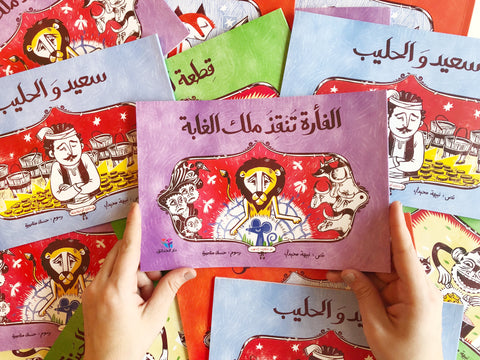We know that reading doesn’t begin at school or when kids are old enough to spell out the words on a page. Reading begins when a child is just a few months old and reading becomes part of their daily routine, most likely as they cuddle up with a parent for bedtime.

When kids are too young to read or even speak, parents should focus on making reading fun and enjoyable. But what about when kids have other distractions that may not keep them as engaged as they once were? We have found these steps help us keep our kids engaged in Arabic reading:
- Set a time to read Arabic!
Sounds simple, but I found that if I don't consciously make an effort to read *Arabic* books, my kids will automatically grab an English book to read. The post-dinner reading time is now reserved for Arabic, and my kids have grown to understand that the books they choose for reading after dinner must be Arabic. So if it’s first thing in the morning, or the last thing before bed, setting a consistent routine helps kids look forward to Arabic reading every day.

- Choose a weekly reading theme
Animals, vehicles, seasons, food, family, planets, professions… we are lucky to have books with so many themes! Feel free to keep your theme simple and open to different interpretations. So far we’ve had an animal themed reading session where my kids pick out all their favorite books that have animals. It’s helped me focus on what they want to read, and they feel ownership by getting to choose the books. So instead of simply saying “go get an Arabic book to read,” I say “choose three Arabic books that have an animal as the main character for us to read.” They negotiate with each other which of the books they want to read, and agree amongst themselves before coming to me with their choices. We’ve also kept our themes super simple, like “choose two Arabic books that have blue covers.”

- Use props or voices to bring the story to life
Have a puppet lying around that can read the story to kids? Use it! Or how about *making* a puppet with the kids for story time? Simple props used during story time can help kids stay engaged and want you reading more! Check out our Pinterest page for ideas on puppet-making for story time. And if you’re not crafty and don’t have puppets--using your voice and facial expressions can bring the different characters in each story to life. As a baby, my son *loved* when I would use my “big man voice” when reading Omar is Lost and would giggle incessantly and ask me to repeat the lines of the story in that voice.

- Ask questions and allow time for answers
“Who did Dana invite to her party?”, “What does فلاح mean?”, “If you could be an author, what would you write about?”--these are just a few questions that can spark a conversation around what we are reading and build a child’s Arabic vocabulary. I try to ask at least three questions throughout the reading process to keep my boys engaged, and to build their Arabic vocabulary. I will usually ask them the question in Arabic and while they may answer in English, we work on repeating the answer in Arabic so the vocabulary sticks! And questions shouldn’t be reserved for the parent reading the book to the child--allow your kids to ask you questions they have around the story and its content (this shows they are understanding and interested in it!).

What are your tips and tricks for keeping kids engaged in Arabic reading? Share them with us!